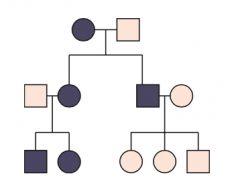![]()
![]()
![]()
Use LEFT and RIGHT arrow keys to navigate between flashcards;
Use UP and DOWN arrow keys to flip the card;
H to show hint;
A reads text to speech;
15 Cards in this Set
- Front
- Back
|
Codominance |
Both alleles contribute to the phenotype of the heterozygote |
|
|
Variable experssivity |
Phenotype varies among individuals w/ same genotype (e.g.: neurofibromatosis 1) |
|
|
Incomplete penetrance |
Not all individuals w/ mutant genotype show the same phenotype (e.g.: BRCA1 gene mutations don't always result in breast or ovarian cancer) |
|
|
Pleotropy |
One gene contributes to multiple phenotypic effects (e.g.: untreated PKU) |
|
|
Linkage disequilibrium |
Tendency for certain alleles at 2 linked loci to occur together more or less often than expected by chance |
|
|
Mosaicism |
Presence of genetically distinct cell lines in the same individual |
|
|
Locus heterogeneity |
Mutations at different loci can produce a similar phenotype |
|
|
Heteroplasmy |
Presence of both normal & mutated mtDNA -- results in variable expression in mitochondrially inherited diseases |
|
|
Imprinting |
At the same loci, only 1 allele is active; the other is inactive (imprinted/inactivated by methylation)
Deletion of the active allele results in disease |
|
|
Prader-willi syndrome |
Maternal imprinting: gene from mom is normally silent & paternal gene is deleted |
|
|
Angelman syndrome |
Paternal imprinting: gene from dad is normally silent & maternal gene is deleted/mutated |
|

|
X-linked recessive
1. More severe in males; females need to be homozygous to be affected
2. No male-to-male transmission
3. Can skip generations
4. Sons of heterozygous mothers have a 50% chance of being affected |
|

|
Mitochondrial inheritance
1. transmitted ONLY THROUGH HTE MOTHER
2. All offspring of affected females may show signs of disease |
|
|
List some autosomal dominant diseases |
AD PKD
FAP
Familial Hypercholesterolemia (no LDL R)
Hereditary Spherocytosis
Huntingtons
Marfan's
MEN (1, 2A, 2B)
NF1, NF2
VHL
Tuberous Sclerosis |
|
|
X-linked recessive disorders (REMEMBER: NO MALE TO MALE TRANSITION) |
Bruton agammaglobulinemia Wiskott-Aldrich syndrome G6PD deficiency
Lesch-Nyhan syndrome Duchene & Becker muscular dystrophy Hemophilia A, B
|

